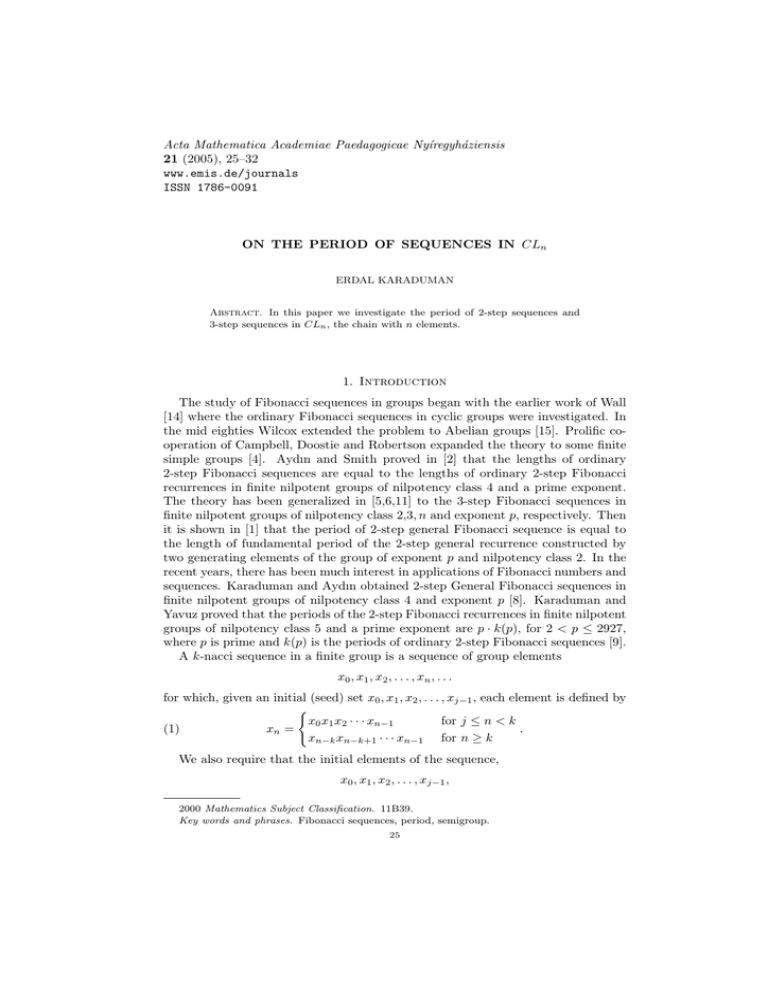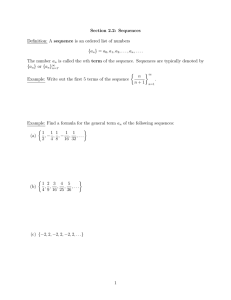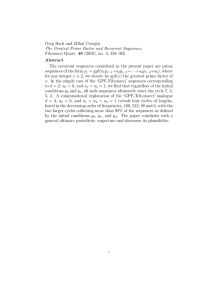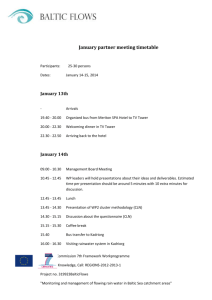Acta Mathematica Academiae Paedagogicae Ny´ıregyh´aziensis 21 (2005), 25–32 www.emis.de/journals ISSN 1786-0091
advertisement

Acta Mathematica Academiae Paedagogicae Nyı́regyháziensis
21 (2005), 25–32
www.emis.de/journals
ISSN 1786-0091
ON THE PERIOD OF SEQUENCES IN CLn
ERDAL KARADUMAN
Abstract. In this paper we investigate the period of 2-step sequences and
3-step sequences in CLn , the chain with n elements.
1. Introduction
The study of Fibonacci sequences in groups began with the earlier work of Wall
[14] where the ordinary Fibonacci sequences in cyclic groups were investigated. In
the mid eighties Wilcox extended the problem to Abelian groups [15]. Prolific cooperation of Campbell, Doostie and Robertson expanded the theory to some finite
simple groups [4]. Aydın and Smith proved in [2] that the lengths of ordinary
2-step Fibonacci sequences are equal to the lengths of ordinary 2-step Fibonacci
recurrences in finite nilpotent groups of nilpotency class 4 and a prime exponent.
The theory has been generalized in [5,6,11] to the 3-step Fibonacci sequences in
finite nilpotent groups of nilpotency class 2,3, n and exponent p, respectively. Then
it is shown in [1] that the period of 2-step general Fibonacci sequence is equal to
the length of fundamental period of the 2-step general recurrence constructed by
two generating elements of the group of exponent p and nilpotency class 2. In the
recent years, there has been much interest in applications of Fibonacci numbers and
sequences. Karaduman and Aydın obtained 2-step General Fibonacci sequences in
finite nilpotent groups of nilpotency class 4 and exponent p [8]. Karaduman and
Yavuz proved that the periods of the 2-step Fibonacci recurrences in finite nilpotent
groups of nilpotency class 5 and a prime exponent are p · k(p), for 2 < p ≤ 2927,
where p is prime and k(p) is the periods of ordinary 2-step Fibonacci sequences [9].
A k-nacci sequence in a finite group is a sequence of group elements
x0 , x1 , x2 , . . . , xn , . . .
for which, given an initial (seed) set x0 , x1 , x2 , . . . , xj−1 , each element is defined by
(
x0 x1 x2 · · · xn−1
for j ≤ n < k
(1)
xn =
.
xn−k xn−k+1 · · · xn−1 for n ≥ k
We also require that the initial elements of the sequence,
x0 , x1 , x2 , . . . , xj−1 ,
2000 Mathematics Subject Classification. 11B39.
Key words and phrases. Fibonacci sequences, period, semigroup.
25
26
ERDAL KARADUMAN
generate the group, thus forcing the k-nacci sequence to reflect the structure of the
group. The k-nacci sequence of a group generated by x0 , x1 , x2 , . . . , xj−1 is denoted
by Fk (G; x0 , x1 , . . . , xj−1 ).
2-step Fibonacci sequence in the integers modulo m can be written as
F2 (Zm ; 0, 1).
We call a 2-step Fibonacci sequence of a group elements a Fibonacci sequence of
a finite group. A finite group G is k-nacci sequenceable if there exists a k-nacci
sequence of G such that every element of the group appears in the sequence.
A sequence of group elements is periodic if, after a certain point, it consists
only of repetitions of a fixed subsequence. The number of elements in the repeating subsequence is called period of the sequence. For example, the sequence
a, b, c, d, e, b, c, d, e, b, c, d, e, · · · is periodic after the initial element a and has period
4. A sequence of group elements is simply periodic with period k if the first k
elements in the sequence form a repeating subsequence. For example, the sequence
a, b, c, d, e, f, a, b, c, d, e, f, a, b, c, d, e, f, · · · is simply periodic with period 6.
Semigroup presentations have been studied over a long period, usually as a means
of providing examples of semigroups. In [10], B.H. Neumann introduced an enumeration method for finitely presented semigruops analogous to the Todd-Coxeter
coset enumeration process for group [13]. For about semigroup presentations see
[12].
Let p denote the period of sequences in CLn , which is a commutative semigroup
with n elements, where n ∈ N . In this paper we prove that the period of 2-step
sequences in CLn is
p = (n − 2)n + 1
and the period of 3-step sequences in CLn is
£¯ n
¯¤
¯ 2 − 1¯ n + 1, if n is even
p = £¯
¯¤
¯n
¯
if n is odd
2 − 1 n + 2,
¯¤
£¯ n
where ¯ 2 − 1¯ is the integer part of | n2 − 1|. Let A be an alphabet. We denote by
A+ the free semigroup on A consisting of all non-empty words over A. A semigroup
presentation is an ordered pair of < A | R >, where R ⊆ A+ XA+ A semigroup S
is said to be defined by the semi group presentation < A | R > if S is isomorphic to
A+ /ρ, where ρ is the congruence on A+ generated by R. Let u and v be two words
in A+ . We write u ≡ v if u and v are identical words, and write u = v if (u, v) ∈ ρ,
that is v is obtained from u by applying relations from R, or equivalently there is
a finite sequence
u ≡ α1 , α2 , α3 , . . . , αn ≡ v
of words from A+ in which every αi is obtained from αi−1 by applying a relation
from R(see [7, Proposition 1.5.9]). If both A and R are finite sets then < A | R >
is said to be a finite presentation. If a semigroup S can be defined by a finite
presentation then S is said to be finitely presented.
Let Yn = {y1 , y2 , y3 , . . . , yn }and let CLn = {Y1 , Y2 , Y3 , . . . Yn }. Consider the
set-theorical union ∪ as a binary operation. With respect to this operation, CLn is
a commutative semigroup of idempotents, and Yn is the zero element of CLn . We
call CLn the chain of order n.
ON THE PERIOD OF SEQUENCES IN CLn
27
Now, we give the following Theorem giving information about the presentation
of CLn .
Theorem 1. The presentation
Pn =< a1 , a2 , a3 , . . . , an |a21 = a1 , ai a2i+1 ai = ai+1 (1 ≤ i ≤ n − 1) >
defines the chain CLn of order n and we have ai aj = aj and aj ai = aj , for
1 ≤ i < j ≤ n.
Proof. Let φ be the homomorphism from Hn , the semigroup defined by Pn , into
CLn defined by ai → Yi . It is clear that φ is onto, and so CLn is homomorphic
image of Hn . Now we show that the order of Hn is n.
From the relations a1 a22 a1 = a2 and a21 = a1 , we have
a1 a2 = a1 (a1 a22 a1 ) = a1 a22 a1 = a2
and
a2 a1 = (a1 a22 a1 )a1 = a1 a22 a1 = a2 .
It follows that a22 = (a1 a2 )(a2 a1 ) = a2 If we continue inductively, we obtain the
followings:
ai ai+1 = ai+1 , ai+1 ai = ai+1
and
a2i+1 = ai+1 (1 ≤ i ≤ n − 1).
For 1 ≤ i < j ≤ n, we show that ai aj = aj and aj ai = aj . For this end, we use
induction on j − i. For j − i = 1, we have just shown. Assume that, for j − i = k,
we have ai ai+k = ai+k . For j − i = k + 1, it follows from
ai+k a(i+k)+1 = a(i+k)+1
that
ai aj ≡ ai ai+k+1 = ai (ai+k ai+k+1 ) ≡ (ai ai+k )ai+k+1 = ai+k ai+k+1 = ai+k+1 ≡ aj
as required. Similarly, we show that aj ai = aj , for 1 ≤ i < j ≤ n, as follow.
For this again, we use induction on j − i. For j − i = 1, we have just shown.
Assume that, for j − i = k, we have aj ai = ai+k ai = ai+k . For j − i = k + 1, it
follows from a(i+k)+1 ai+k = a(i+k)+1 that
aj ai ≡ ai+k+1 ai = (ai+k ai+k+1 )ai ≡ ai+k+1 (ai+k ai ) = ai+k+1 ai+k = ai+k+1 ≡ aj
as required.
Therefore, for every word w ∈ A+ where A = {a1 , a2 , a3 , . . . an }, there exists a
generator ai ∈ A such that the relation w = ai holds in the semigroup Hn defined
by Pn , and hence the order of Hn is n. Therefore Pn defines CLn .
The same proof of this Theorem has been given in [3].
¤
If we define the sequences in CLn as in formula (1), it is clear that the sequences
is periodic and p = n. Now we define 2-step sequences in CLn as xi = xi−n xi−(n−1)
and 3-step sequences in CLn as xi = xi−n xi−(n−1) xi−(n−2) , for i > n.
Theorem 2. Let
Pn =< a1 , a2 , a3 , . . . , an | a21 = a1 , ai a2i+1 ai = ai+1 (1 ≤ i ≤ n − 1) >
be presentation of CLn .
28
ERDAL KARADUMAN
i. 2-step sequences in CLn is periodic and the period of the sequence is equal to
p = (n − 2)n + 1,
ii. 3-step sequences in CLn is periodic and the period of the sequence is equal to
£¯ n
¯¤
¯ 2 − 1¯ n + 1, if n is even
p = £¯
¯¤
¯n
¯
if n is odd
2 − 1 n + 2,
Proof. i. The first n terms of sequence are a1 , a2 , a3 , . . . , an . For simplicity, we
use indices instead of generating elements of CLn in our process. Since xi =
xi−n xi−(n−1) , for i > n, we have
xn+1 = x2 = 2,
xn+2 = x3 = 3,
xn+3 = x4 = 4,
xn+n−1
..
.
= xn = x2n−1 = n,
x2n = xn = n,
x2n+1 = x3 = 3,
x3n+1
..
.
= x4 = 4,
..
.
x(n−2)n+1 = xn−1 = n − 1,
x(n−2)n+2 = xn = n,
from defining relations in CLn . It follows that xj = n for l.n − (l − 1) ≤ j ≤ l.n,
where 1 ≤ l ≤ (n − 2). We also have xj = n and xl.n+1 = x(l−1)n+2 Since the
elements succeeding
x(n−2)n+1 , x(n−2)n+2 ,
depend on n − 1, n for their values, we have
x(n−2)n+m = xn = n
for m > 1. So, 2-step sequences in CLn is periodic and the period of the sequence
is equal to
p = (n − 2)n + 1.
ii. The first n terms of sequence are a1 , a2 , a3 , . . . , an . For simplicity, we use
indices instead of generating elements of CLn in our process. It is clear that the
period of the sequence is 2 when n = 2. Firstly, we consider the case of n is even,
n > 2. Since xi = xi−n xi−(n−1) xi−(n−2) , for i > n, we have
n+1−(n−2)
xn+1 =
Y
xj = x3 = 3,
j=n+1−n
n+1−(n−3)
xn+2 =
Y
j=n+1−(n−1)
xj = x4 = 4,
ON THE PERIOD OF SEQUENCES IN CLn
..
.
n
Y
x2n−2 =
xj = xn = n,
j=n−2
n+1
Y
x2n−1 =
xj = xn = n,
j=n−1
x2n =
n+2
Y
xj = xn = n,
j=n
n+3
Y
x2n+1 =
xj = xn+3 = 5,
j=n+1
n+4
Y
x2n+2 =
xj = xn+4 = 6,
j=n+2
n+5
Y
x2n+3 =
xj = xn+5 = 7,
j=n+3
..
.
x3n =
2n+2
Y
xj = x2n+2 = n,
j=2n
2n+3
Y
x3n+1 =
xj = x2n+3 = 7,
j=2n+1
..
.
x[| n −1|]n =
2
[|
x[| n −1|]n+1 =
2
n−(n−2)
[| n2 −1|]Y
j=[|
n
2 −1
j=[|
xj = xn−1 = n − 1,
|]n−(n−1)
n
2 −1
j=[|
xj = xn = n,
|]n−n
n−(n−3)
|]Y
n
2 −1
[|
x[| n −1|]n+2 =
2
n
2 −1
n−(n−4)
|]Y
n
2 −1
xj = xn = n,
|]n−(n−2)
from defining relations in CLn . Since the elements succeeding
x[| n −1|]n , x[| n −1|]n+1 , x[| n −1|]n+2 , . . . ,
2
2
2
depend on n, n − 1, and n for their values, we have
x[| n −1|]n+m = xn = n
2
29
30
ERDAL KARADUMAN
for m > 1. So, 3-step sequences in CLn is periodic and the period of the sequence
is equal to
¯i
h¯ n
¯
¯
p = ¯ − 1¯ n + 1
2
when n is even. Now we consider the case of n is odd. Since
xi = xi−n xi−(n−1) xi−(n−2)
for i > n, we have
n+1−(n−2)
Y
xn+1 =
xj = x3 = 3,
j=n+1−n
n+1−(n−3)
Y
xn+2 =
xj = x4 = 4,
j=n+1−(n−1)
..
.
n
Y
x2n−2 =
xj = xn = n,
j=n−2
n+1
Y
x2n−1 =
xj = xn = n,
j=n−1
x2n =
n+2
Y
xj = xn = n,
j=n
x2n+1 =
n+3
Y
xj = xn+3 = 5,
j=n+1
x2n+2 =
n+4
Y
xj = xn+4 = 6,
j=n+2
x2n+3 =
n+5
Y
xj = xn+5 = 7,
j=n+2
..
.
x3n =
2n+2
Y
xj = x2n+2 = n,
j=2n
x3n+1 =
2n+3
Y
xj = x2n+3 = 7,
j=2n+1
..
.
x[| n −1|]n =
2
n−(n−5)
[| n2 −1|]Y
j=[|
n
2 −1
|]n−(n−3)
xj = xn = n
ON THE PERIOD OF SEQUENCES IN CLn
x[| n −1|]n+1 =
2
n−(n−6)
[| n2 −1|]Y
j=[|
[|
x[| n −1|]n+2 =
2
n
2 −1
n
2 −1
j=[|
[|
x[| n −1|]n+3 =
2
xj = n − 1,
|]n−(n−5)
n
2 −1
j=[|
xj = n − 2,
|]n−(n−4)
n−(n−7)
|]Y
n
2 −1
31
n−(n−8)
|]Y
n
2 −1
xj = n,
|]n−(n−6)
from defining relations in CLn . Since the elements succeeding
x[| n −1|]n+1 , x[| n −1|]n+2 , x[| n −1|]n+3 , . . . ,
2
2
2
depend on n − 2, n − 1, and n for their values, we have
x[| n −1|]n+m = n
2
for m > 2. So, 3-step sequences in CLn is periodic and the period of the sequence
is equal to
¯i
h¯ n
¯
¯
p = ¯ − 1¯ n + 2.
2
when n is odd.
¤
References
[1] H. Aydın and R. Dikici. General Fibonacci sequences in finite groups. Fibonacci Quart.,
36(3):216–221, 1998.
[2] H. Aydın and G. C. Smith. Finite p-quotients of some cyclically presented groups. J. London
Math. Soc. (2), 49(1):83–92, 1994.
[3] H. Ayık, M. Minisker, and B. Vatansever. Minimal presentations and embedding into inefficient semigroups. Algebra Coloquium, 10, 2003.
[4] C. M. Campbell, H. Doostie, and E. F. Robertson. Fibonacci length of generating pairs in
groups. In Applications of Fibonacci numbers, Vol. 3 (Pisa, 1988), pages 27–35. Kluwer
Acad. Publ., Dordrecht, 1990.
[5] R. Dikici and G. C. Smith. Recurrences in finite groups. Turkish J. Math., 19(3):321–329,
1995.
[6] R. Dikici and G. C. Smith. Fibonacci sequences in finite nilpotent groups. Turkish J. Math.,
21(2):133–142, 1997.
[7] J. M. Howie. Fundamentals of semigroup theory, volume 12 of London Mathematical Society
Monographs. New Series. The Clarendon Press Oxford University Press, New York, 1995.
Oxford Science Publications.
[8] E. Karaduman and H. Aydın. General 2-step Fibonacci sequences in nilpotent groups of
exponent p and nilpotency class 4. Appl. Math. Comput., 141(2-3):491–497, 2003.
[9] E. Karaduman and U. Yavuz. On the period of Fibonacci sequences in nilpotent groups. Appl.
Math. Comput., 142(2-3):321–332, 2003.
[10] B. Neumann. Some remarks on semigroup presentations. Can. J. Math., 19:1018–1026, 1968.
[11] E. Özkan. 3-step Fibonacci sequences in nilpotent groups. Appl. Math. Comput., 144(23):517–527, 2003.
[12] E. F. Robertson and Y. Ünlü. On semigroup presentations. Proc. Edinburgh Math. Soc. (2),
36(1):55–68, 1993.
[13] J. A. Todd and H. S. M. Coxeter. A practical method for enumerating cosets of a finite
abstract group. Proc. Edinb. Math. Soc., 5:26–34, 1936.
[14] D. D. Wall. Fibonacci series modulo m. Amer. Math. Monthly, 67:525–532, 1960.
[15] H. J. Wilcox. Fibonacci sequences of period n in groups. Fibonacci Quart., 24(4):356–361,
1986.
32
ERDAL KARADUMAN
Received May 25, 2004; revised September 13, 2004.
Department of Mathematics,
Faculty of Art and Science,
Atatürk University,
25240 Erzurum, TURKEY
E-mail address: eduman@atauni.edu.tr







